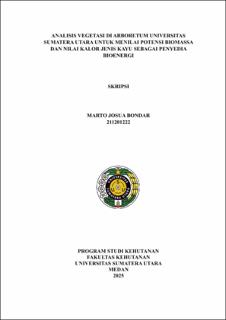Analisis Vegetasi di Arboretum Universitas Sumatera Utara untuk Menilai Potensi Biomassa dan Nilai Kalor Jenis Kayu sebagai Penyedia Bioenergi
Vegetation Analysis at the Arboretum of Universitas Sumatera Utara to Assess the Potential Biomass and Specific Calorific Value of Wood as a Bioenergy Provider.

Date
2025Author
Bondar, Marto Josua
Advisor(s)
Nuryawan, Arif
Patana, Pindi
Metadata
Show full item recordAbstract
The Arboretum of Universitas Sumatera Utara (USU) is a conservation area and green open space that has an important role in supporting exsitu conservation efforts of various species of flora, especially trees. The identification of the types of trees in the USU arboretum is very important as a reference in formulating the right conservation strategy in the future. This study aims to analyze the potential of wood as bioenergy providers at the Arboretum of USU and evaluate the calorific value of various types of wood found in the USU Arboretum. This research was carried out with a census approach, analyzing all plants growing in the arboretum area. Using vegetation analysis methods to assess plant growth rates, which include seedlings, sapling, poles, as well as trees. The data collection process is divided into two categories, namely primary data and secondary data. Primary data were obtained through direct observation at the research site to measure the diameter and height of the plant. Meanwhile, secondary data are based on journals or literature studies used to analyze bioenergy potential. The results of the study showed that in the USU arboretum there were 47 species of trees that have been successfully identified. Among all these species, Alstonia scholaris stands out as the species with the largest number of individuals, reaching 541 individuals or about 11.82%. Data from journals and studies showed that there are 42 types of trees that can be a source of bioenergy. All of these types of trees have a caloric value of more than 4000 ccal/g.
Collections
- Undergraduate Theses [2162]
